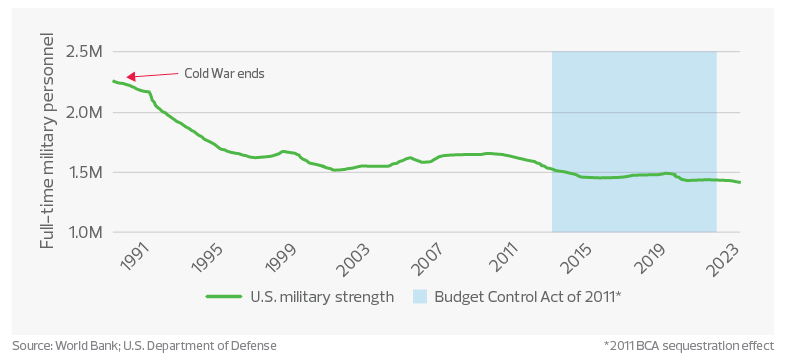The federal government is looking to leverage technology and AI to maintain its military advantage.
Key takeaways
Government contractors must be ready to supply the government’s urgent military needs.
Contractors can capitalize on funding for governmental technology and AI requirements.
Technology is the key to our nation maintaining its global competitive advantage. We are accustomed to hearing about corporate strategies, but do nations have strategies as well? They do, and a nation’s strategy is commonly referred to as an industrial policy. The United States’ industrial policy includes vertically integrating defense manufacturing by reshoring semiconductor production and investing in research and development to create the technology needed to compete globally, providing the bandwidth, tactical prowess and speed to defend our nation.
As tensions continue to rise between the U.S. and China, and conflicts persist elsewhere in the world, our nation’s leaders are assessing the current state of our military. The technology our defense industrial base provides will be vital in maintaining a competitive military advantage over near-peer threats with greater size and scale.
The government will likely leverage the rapid advancement of artificial intelligence (AI) and further development of unmanned vehicles to accelerate military capacity while improving tactical prowess. Government contractors, in turn, will need to align their strategies and enhance their functional operations to meet the demands of their federal government customers with equal speed and technical advancement.
Military capacity
According to Global Firepower, our nation still has the most powerful military in the world. However, the U.S. has experienced a steep, continued decline in military capacity due to decreased government funding. In 1953, the U.S. military funding was 11.3% of gross domestic product (GDP), but it is projected to be only 2.7% in 2024, according to the Department of Defense (DoD). Multiple factors contributed to the decline, including the rising costs of mandatory spending and net interest driven higher by elevated inflation without increased taxes. U.S. defense spending and GDP are trending opposite of China, where GDP is expected to grow by 4.5%, and defense spending is set to be 7.2% of GDP in 2024.
It's anticipated that inflation and caps in defense funding will decrease DoD purchasing power in the coming years, leading to a cut in personnel. As shown in the graph, our U.S. military strength has declined slightly since the Cold War ended. In December, the Congressional Budget Office provided three alternatives to reduce the DoD’s annual budget. All three reduction alternatives would be achieved by decreasing the number of full-time military personnel between 18% and 21%, primarily affecting the U.S. Army and Air Force.

In 2022, China surpassed the U.S. with the largest navy fleet, 348 principal combat ships compared to 296, respectively.
So how does the U.S. bridge the capacity gap while reducing the workforce? The answer is technology. As opportunity costs rise in a time of declining budgets, it is imperative to leverage technological solutions. In this case, the solution is using unmanned vehicles under the DoD’s Replicator program. Deputy Secretary of Defense Kathleen Hicks said the initiative will use “existing funding, existing programming lines and existing authorities to accelerate production and delivery at scale.” This program will put fewer people in the line of fire by utilizing self-piloting ships and unmanned aerial vehicles.
Middle market companies will need to escalate production quickly to support the government’s strategic vision. This new approach to scaling military power will open the door to emergent technologies, increasing military bandwidth. Service providers and manufacturers will face increased operational demands such as workforce planning and inventory optimization, requiring these middle market businesses to transform their corporate strategies and functional operations.
Tactical prowess
The power of computational processing will dictate the future of defense. A data-driven future will help the U.S. anticipate each move of its adversary like a chess match. A few years ago, the vision of the Joint Staff National Military Strategy included the ability to outthink, outmaneuver and outfight any adversary. With the rapid evolution of AI, Bloomberg’s analysts have coined a shorter version of this vision: “Outthink to outfight.”
CONSULTING INSIGHT: Generative AI
Generative AI is revolutionizing the development and delivery of products and services, and many organizations are working to understand how to effectively utilize the technology. Gain insights into how you can capitalize on the generative AI trend by increasing the value of key processes while mitigating risks.
Special report
The middle market is embracing AI to drive innovation and efficiency
- What are the key organizational areas in which AI is making an impact?
- How are companies measuring their return on investment for AI?
- What is the future of AI for the middle market?
In just 20 years, China’s military has gone from the industrial to the information age. We fear that China could surpass U.S. military strength and superiority with AI.
The U.S. has the most private investment in AI in the world. As such, it is imperative to safeguard the intellectual property and technology developed in the United States. AI is currently on the U.S. Critical and Emerging Technologies List, which makes it subject to export controls and restrictions during a transaction involving foreign ownership, control or influence under the Committee on Foreign Investment in the United States.
Middle market contractors must be ready to capitalize on U.S. government grant and contract funding for AI while understanding government restrictions on transmitting, processing or storing federally regulated sensitive data. We expect these opportunities to affect an array of contractors including service providers that train AI and manufacturers that provide technology components, like semiconductors.
Speed
The Times of London opened a news article on the war between Ukraine and Russia with the following statement: “Ukrainian soldiers have revolutionized the way battles will be fought in the 21st century by waging an ‘algorithmic war’ that enables Kyiv to outgun invading forces with far fewer troops.”
We are watching a real-life demonstration of how technology enables a digital force to outsmart a much larger analog adversary. Ukraine uses AI to identify targets by rapidly leveraging data from multiple sources, including heat sensors, satellite imagery and mobile signals. The advantage is simple: protect and defend faster via quicker analysis and decision making using AI.
Specifically, the generative AI market is expected to grow at exponential rates and reach over $1 trillion by 2032, according to Bloomberg Intelligence. Cybersecurity, drug discovery, AI assistants and coding workflow are among the software categories most likely to drive growth.
With a strategically designed cost-accounting structure, government contractors can shield their commercial business from government-specific requirements while capitalizing on dual-use technology. Understanding how to support fair and reasonable prices by leveraging commercial sales will be critical to expediting the contracting process and reducing the regulatory burden when selling AI solutions to the government.
The takeaway
China currently outnumbers the U.S. in certain areas of military capacity, and we fear that in the not-so-distant future, it may surpass our nation in overall military power. The U.S. budget does not provide the nation with the resources to simply build or hire enough military personnel to keep our prominence. Therefore, the government needs to focus on technology to bridge the gap in bandwidth and leverage technology and AI to maintain tactical prowess and improve the speed of action. As shown in the recent conflict between Ukraine and Russia, it is not how many resources a country has but how that country makes fast, educated and efficient data-driven choices.
Middle market government contractors must be ready to supply the government’s urgent military needs. Eligibility to bid and receive contracts and grants, and operational excellence to produce quickly, will be table stakes. We foresee that government contractors, now more than ever, will need compliant functional processes, necessary certifications and audits, and operational capabilities to have the required speed without compromising quality.
RSM contributors
Q2 2024 Middle Market Business Index (MMBI)
Sentiment improves as firms look to invest
Key findings:
- The MMBI rose to 132.0 in the second quarter from 130.7 in the prior period.
- Forty percent of senior executives indicated that the economy had improved.
- A majority of executives intend to boost capital expenditures over the next six months.


